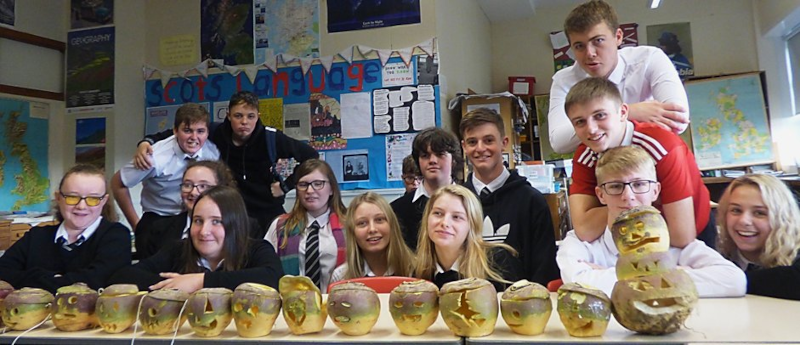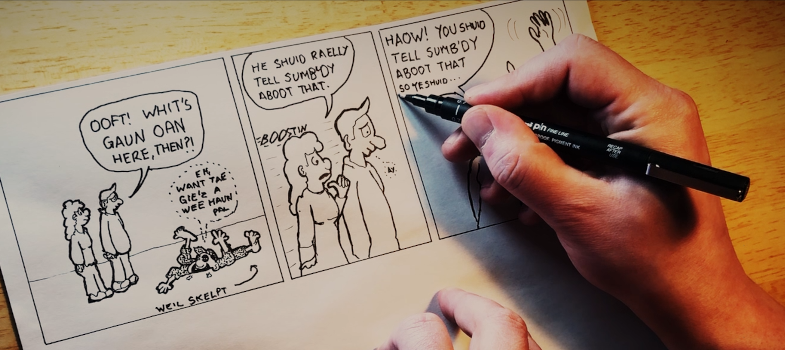Scots and Social Studies at Secondary School

© Jamie Fairbairn
11. Further reading
- CfE Outcomes
Read this overview of all activities in this unit and how they link with the SQA Scots Language Award, the Scottish Studies Award the Social Studies Curriculum.
|
Scots course activities, themes |
Curriculum links |
|
Scots place-names |
|
|
Scots landscape features |
I can use a range of maps and geographical information systems to gather, interpret and present conclusions and can locate a range of features within Scotland, UK, Europe and the wider world. SOC 3-14a
National / Higher Geography. Physical Environments. Glaciations, Coasts, Rivers. |
|
Using Scots language sources to understand and add meaning to the Picts, The Wars of Independence, James VI, and WWI. |
I can use my knowledge of a historical period to interpret the evidence and present an informed view. SOC 3-01a
National 5 / Higher History: Scottish History Wars of Independence (Wallace & Bruce) Era of the Great War (Scots on the Western Front) Higher History: Reformation, James VI. |
|
Historical sources in Scots. History and development of the Scots tongue. |
I can make links between my current and previous studies and show my understanding of how people and events have contributed to the development of the Scottish nation. SOC 3-02a |
|
Influence of other languages on Scots. Norse settlers, The Auld Alliance, Flemish trade and tradespeople, Timber trade with Norway. |
I can explain why a group of people from beyond Scotland settled here in the past and discuss the impact they have had on the life and culture of Scotland. SOC 3-03a |
|
Scots and Politics |
I can explain why a group I have identified might experience inequality and can suggest ways in which this inequality might be addressed. SOC 3-16a
I can evaluate conflicting sources of evidence to sustain a line of argument. SOC 4-15a
I can contribute to a discussion on the extent to which people’s needs should be met by the state or the individual. SOC 4-16a
I can evaluate the impact which decision-making bodies have ion the lives of people in Scotland or elsewhere. SOC 4-18a |
- You may want to explore Unit 10 of the OU’s Scots language and culture course in more detail, as it provides useful materials for areas covered in this unit and explores in depth aspects of the world of work in relation to Scots language. You could also consider asking your students to study parts of the unit online themselves, depending on the age group you are teaching and their access to online study resources.
- Jock Duncan (2018). Jock’s Jocks. Voices of Scottish Soldiers from the First World War. Edited by Gary West. NMSE Publishing Ltd./European Ethnological Research Centre. Theatre production based on the book: Jock's Jocks from the Scottish Storytelling Centre on Facebook.
- Billy Kay (1986). Scots. The Mither Tongue. Mainstream Publishing Company.
- Derrick McClure (1988). Why Scots Matters. The Saltire Society, Edinburgh.
- Robert McColl Millar (2020). A Socio-linguistic history of Scots. Edinburgh University Press.
- Claire Needler, Jamie Fairbairn (2020). Local Language, School and Community: Curricular Innovation Towards Closing the Achievement Gap. A BCF Curriculum Investigation Grant Report. British Educational Research Association BERA.
-
Local language, school and community: Curricular innovation towards closing the attainment gap. An investigation of how schools can, by working in and with local languages and dialects, raise pupils' educational attainment, cultural awareness and self-esteem.
-
Claire Needler, Jamie Fairbairn (2020). ‘How do you feel about the language that you use?’: Promoting Attitudinal Change Among Scots Speakers in the Classroom. Chapter in: Transformative Pedagogical Perspectives on Home Language Use in Classrooms. IGI Global
- Scottish Language Dictionaries (2017). Concise Scots Dictionary, 2nd Edition. Edinburgh University Press.
- Scottish National Dictionary Association (1990). Scots Thesaurus. Polygon at Edinburgh.
- Amanda Thomson (2018). A Scots Dictionary of Nature. Saraband, Glasgow.
-
The Story of Poem 49: Social Studies
Third / Fourth Level and adaptable for the Senior Phase
This lesson plan will support you to deliver lessons about early modern Scotland’s attitudes towards gender and sexuality, particularly those of the church and the state. This is framed as the context for Poem 49 of The Maitland Quarto Manuscript, a same-sex love poem written in the Scots language. The lesson offers several case studies which highlight how social norms were upheld through the threat of capital punishment: the criminalisation of homosexuality and the Scottish witchcraft trials.
This resource pack includes a powerpoint, teaching notes, and supporting resources.
Access: Secondary Resources on tie.scot
Interpreting Poem 49
Literacy and English / Languages
Third and Fourth Level
This lesson plan will support you to deliver lessons about Poem 49 of The Maitland Quarto Manuscript; a same-sex love poem written in the Scots language. This poem has become an important artefact in Scotland’s LGBT history. In the lesson, learners will be introduced to a historical overview of the author, believed to be Marie Maitland, and her family, as well as a brief historical context for when it was written. The poem is then broken down stanza by stanza for analysis and interpretation.
This resource pack includes a powerpoint, teaching notes, a close reading of Poem 49, and supporting resources.
Access: Secondary Resources on tie.scot
- Connected to the LGBTQ+-Inclusive Education resources, you might find the free professional
learning programme developed by TIE useful. This goes beyond the teaching of Scots but it explores wider issues connected to inclusive education. Stage 1 of this course is an instantly accessible E-Learning module, and
teachers will receive CPD certificates upon completion. Further information is
available here: Teachers on tie.scot.
